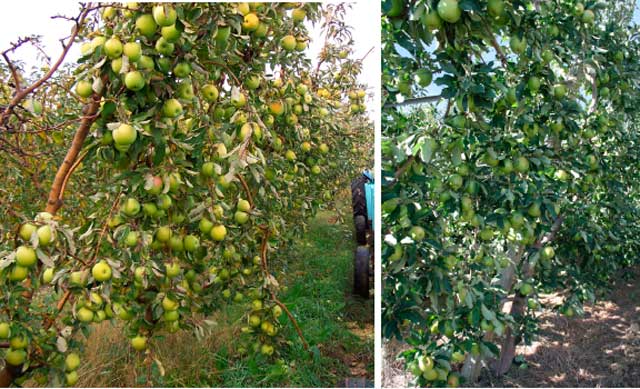In summer the structure of the tree itself will make some sunlight unavailable to leaves.
Tree structure and shade (Continued from last issue)
In large, old over-limbed trees, an estimated 60 per cent of the incoming sunlight is lost by the shade that the woody structure casts upon the leaves. Far less sunlight is lost by younger and smaller trees with simple tree structures.
In winter when fruit trees are bare is a good time to look at the structure of the trees, limb placement and number, the height of the trees and how much shade a tree casts when its leaves are gone.
You will be surprised how much shadow a tree can give in winter when it has no leaves
In some cases the scaffold structure of old trees will create large shadows, up to 30 to 40 per cent on the orchard floor, even when there aren’t any leaves. This can translate into severe shading problems during the next season when you want the leaves to absorb the sunlight, not the tree scaffold structure.
The tree structure should allow the tree to hang as much fruit as possible without having superfluous structure.
The carryover effect of shading
UK research
In detailed studies in England, researchers shaded whole apple trees to provide three levels of shade: 37 per cent, 25 per cent and 11 per cent of full sunlight, in addition to 100 per cent full sunlight.
Fruit set
During the summer, fruit set was reduced in the shaded trees. The trees which received just 25 per cent of full sunlight had only 63 per cent of the fruit set found on trees which received 100 per cent full sunlight. This led to a direct reduction in the number of fruit per tree.
Fruit size
Fruit size was also reduced but not as badly, with trees receiving 25 per cent of full sunlight having apples 83 per cent as large as those on trees receiving 100 per cent of full sunlight.
Yield
The combination of reduced fruit numbers and reduced fruit size resulted in very significant reductions in yield per tree. Trees receiving 25 per cent of full sunlight had yields of just 52 per cent of the trees receiving 100 per cent of full sunlight.
USA research
Similar trends with Red Delicious trees in the USA showed that skin colour, fruit size and soluble solids were reduced in proportion to the increasing levels of shading.
A carryover effect of shading during one season on fruit production in a second season was also studied.
Flower clusters
Trees that were shaded the first season but received full sunlight the second season, showed very drastic reductions in the number of flower clusters per tree in the second year.
Trees receiving just 25 per cent of full sunlight in the first year had the number of flower clusters reduced by 49 per cent of full sunlight trees. Fruit set during the second year was reduced only on trees receiving 11 per cent of full sunlight.
These reductions in cluster number and fruit set led to large reductions in the number of fruits per tree.
Fruit size during the second year on the shaded trees was slightly larger than on the trees that received full sunlight. This occurred because the trees had very few fruits. The combined effect of reduced fruit numbers and little change of fruit size resulted in large differences in yield.
Trees which received 25 per cent of full sunlight produced just 54 per cent of the yield of trees receiving 100 per cent full sunlight.
The results are important, and may surprise many fruit growers because these significant reductions in yield occurred during a season when the trees received full sunlight. The yield reductions were a carryover effect resulting from shading during the previous season.
There is little doubt that such carryover yield reductions occur with many types of fruit, not only apples.
Transient shade is good shade
If light distribution is poor, shading can become so severe that fruit number and fruit quality are reduced. However, temporary shade or transient shade can be beneficial.
In hot, sunny climates, heavy shade can be harmful, but limited shade can be helpful.
In the upper, outside areas of tree canopies, fruit may be exposed to full sunlight and become sunburnt. In many sunny fruit growing districts it is necessary to provide some transient shade to protect fruit from sunburn.
Pruning that reduces sunburn
Certain methods of pruning can be used to create transient shade and reduce sunburn. Fruiting branches and fruiting units which are stiff and allow limited fruit movement during the growing season, have less fruit sunburn.
When a fruit skin moves from a shaded to a sunny position on hot days it usually sunburns badly. Branches and fruiting wood can be stiffened by making heading cuts into one-year-old or older wood. This method is called ‘short pruning’ as opposed to ‘long pruning’ where fruiting wood is left with long ‘hangers’ that gradually bend under the weight of the fruit that can then sunburn.
See this article in Tree Fruit May 2022






















